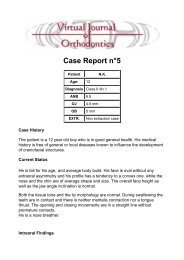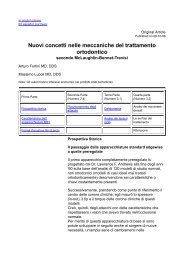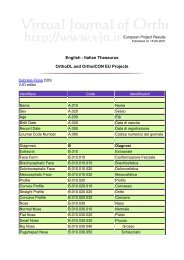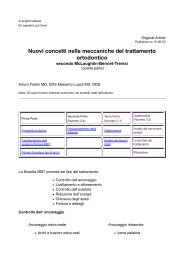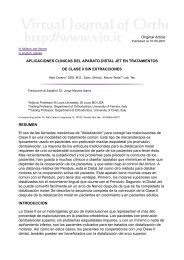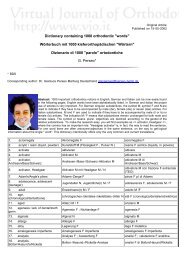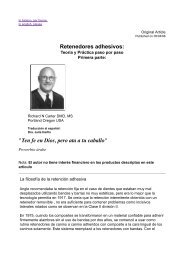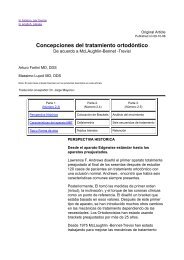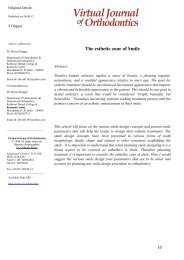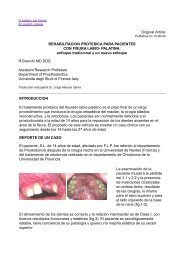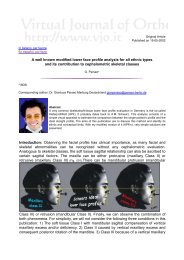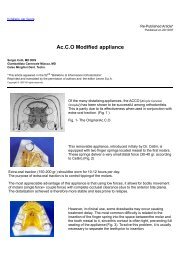Orthodontic treatment conceptions - Virtual Journal of Orthodontics
Orthodontic treatment conceptions - Virtual Journal of Orthodontics
Orthodontic treatment conceptions - Virtual Journal of Orthodontics
Create successful ePaper yourself
Turn your PDF publications into a flip-book with our unique Google optimized e-Paper software.
In italiano, per favore<br />
En español, por favor<br />
Arturo Fortini MD, DDS<br />
Massimo Lupoli MD, DDS<br />
<strong>Orthodontic</strong> <strong>treatment</strong> <strong>conceptions</strong><br />
according to McLaughlin-Bennet-Trevisi<br />
Note: The authors have financial interest in the products described in this article.<br />
Original Article<br />
Published on 09-10-98<br />
Part 1.<br />
(Issue 2.3)<br />
Part 2.<br />
(Issue 2.4)<br />
Part 3.<br />
(Issue 2.5)<br />
Historical Perspective Bracket Placement Dental Movement Analysis<br />
MBT Appliance Characteristics Cephalometrics Six Sequences <strong>of</strong> Treatment<br />
Arch Shape and Arch Forms S<strong>of</strong>t Tissues Retention<br />
Historical Perspective<br />
From standard Edgewise to pre-adjusted appliances.<br />
Lawrence F. Andrews designed the first totally<br />
pre-adjusted appliance in the late sixties after studying 120<br />
casts <strong>of</strong> nonorthodontic patients with normal occlusion.<br />
Andrews found that six common characteristics were<br />
always present.<br />
Later he took the first order measurements (in/out), the tip,<br />
and the torque <strong>of</strong> the clinical crowns as a point <strong>of</strong><br />
reference. He then made a bracket based on these values.<br />
After this first kind <strong>of</strong> appliance, many other changes were<br />
introduced into <strong>treatment</strong> mechanics depending on the<br />
necessities. Orthodontists have now used pre-adjusted<br />
brackets for over 25 years.<br />
Since 1975 McLaughlin -Bennet-Trevisi have been<br />
working to improve <strong>treatment</strong> mechanics for the new<br />
generation <strong>of</strong> pre-adjusted brackets. While trying to devise<br />
an approach using lighter forces, they also worked on<br />
developing different types <strong>of</strong> tubes and brackets. The use<br />
<strong>of</strong> these different brackets and tube types in several<br />
clinical applications brought, as a result, the improvement
<strong>of</strong> full working appliances with the same mechanics as<br />
suggested by the authors.<br />
The six keys to normal occlusion (Andrews, 1972)<br />
1. Molar relation<br />
2. Crown tip<br />
3. Crown torque<br />
4. Lack <strong>of</strong> rotations<br />
5. Tight contacts<br />
6. Occlusal plane<br />
Key 1: Molar relationship<br />
1- The mesiobuccal cusp <strong>of</strong> the upper fist permanent<br />
molar falls within the groove between the mesial and<br />
middle cusps <strong>of</strong> the lower first permanent molar.<br />
2- The mesiolingual marginal ridge <strong>of</strong> the upper first<br />
permanent molar occludes with the marginal ridge <strong>of</strong> the<br />
lower permanent second molar.<br />
3- The mesiolingual cusp <strong>of</strong> the upper first permanent<br />
molar occludes with the central fossa <strong>of</strong> lower first<br />
permanent molar.<br />
4- The buccal cusps <strong>of</strong> the upper bicuspids are in a<br />
cusp-embrasure relationship with the lower bicuspids.<br />
5- The lingual cusps <strong>of</strong> the upper bicuspids are in a<br />
cusp-fossa relationship with the lower bicuspids.<br />
6- The upper cuspids are in a cusp-embrasure relationship<br />
with the lower cuspid and lower first bicuspid.<br />
7- The upper and lower incisors contact and the midlines<br />
are coincident.
Key 2: Crown angulation, the mesiodistal "tip"<br />
Crown tip or mesiodistal tip refers to angulation (or tip) <strong>of</strong><br />
the long axis <strong>of</strong> the crown, not to angulation <strong>of</strong> the long<br />
axis <strong>of</strong> the entire tooth. In normal occlusion, the gingival<br />
portion <strong>of</strong> the long axis <strong>of</strong> each crown is distal to the incisal<br />
portion, varying with the individual tooth type. The degree<br />
<strong>of</strong> crown tip is the angle between the long axis <strong>of</strong> the<br />
crown (as viewed from the labial or buccal surface) and a<br />
line bearing 90 degrees from the occlusal plane.<br />
Key 3: Crown angulation, labiolingual or buccolingual<br />
inclination ("torque")<br />
Torque is expressed in plus or minus degrees,<br />
representing the angle formed by a line which bears 90<br />
degrees to the occlusal plane and a line that is tangent to<br />
the middle <strong>of</strong> the labial or buccal long axis <strong>of</strong> the clinical<br />
crown. A plus reading is given if the gingival portion <strong>of</strong> the<br />
tangent line is lingual to the incisal portion. A minus<br />
reading is recorded when the gingival portion <strong>of</strong> the<br />
tangent line is labial to the incisal portion.<br />
Key 4: Rotations<br />
The teeth should be free <strong>of</strong> undesirable rotations. For<br />
example, rotated molars occupy more space than normal,<br />
creating a situation unreceptive to normal occlusion.
Key 5: Tight contacts<br />
The contact points should be tight (no spaces).<br />
Key 6: Occlusal Plane<br />
According to Andrews, a flat plane should be a <strong>treatment</strong><br />
goal as a form <strong>of</strong> over<strong>treatment</strong>. A deep curve <strong>of</strong> Spee<br />
results in a more contained area for the upper teeth,<br />
making normal occlusion impossible. A reverse curve <strong>of</strong><br />
Spee is an extreme form <strong>of</strong> over<strong>treatment</strong>, allowing<br />
excessive space for each tooth to be intercuspally placed.<br />
According to Roth, the goals <strong>of</strong> a functional occlusion are<br />
as below:<br />
1- Centric occlusion is coincident with centric relation<br />
2- Class I relationship or cusp to marginal ridge<br />
relationship<br />
3- Even force distribution in the posterior<br />
4- In protrusive excursion, eight lower anterior teeth should<br />
be in contact with six upper anterior teeth.<br />
5- Lowest anterior slot - 1mm back disclosure.<br />
6- Lateral cuspid slot with the lowest back disclosure.<br />
MBT appliance characteristics<br />
1- Tip in the slot<br />
2- Torque at the base<br />
3- In/out at the base<br />
4- Round base<br />
5- Specific modelling <strong>of</strong> brackets<br />
6- I.D. System.<br />
The torque and the In/out that are incorporated in the<br />
bracket base are the most important characteristic <strong>of</strong> the<br />
pre-adjusted appliance. They allow the proper force<br />
application through the centre <strong>of</strong> the slot and the base
eing coincident. As a result <strong>of</strong> this detail, it is possible to<br />
align the slots on the Andrews’ plane and consequently on<br />
the arch with a straight wire. The appliance having the<br />
torque on the slot will never be able to accomplish this.<br />
The brackets used in the original techniques are twin or<br />
Siamese brackets with the 0.022x0.028 slot assuring a<br />
strict relation between the archwire and the slots thus<br />
allowing good working mechanics.<br />
Anterior bracket tips<br />
Tip measurements for anterior teeth in the MBT appliance<br />
are according to Andrews’ original research where the<br />
static ideal and the functional ideal occlusion described by<br />
Roth are respected.<br />
The only differences are the upper anteriors (10° less<br />
distal crown tip) and the lower anteriors (12° less).<br />
According to the authors, these changes allow better<br />
anchorage control and when using light forces there is no<br />
opposite tip effect caused by torque, the phenomenon<br />
Andrews referred to as the "Wagon wheel effect".<br />
Upper posterior bracket tips<br />
The MBT appliance provides 0° tip in upper bicuspid<br />
brackets to keep them in a more vertical position<br />
conducive to Class I occlusion. Upper molar tubes also<br />
have 0° tip. Since the point <strong>of</strong> reference for those teeth is<br />
the vestibular slot, having a 5° tip with respect to a<br />
perpendicular line to the occlusal plane will give the upper<br />
first and second molars 5° tip with respect to the buccal<br />
slot.<br />
Lower posterior teeth<br />
2° tip is provided in the lower bicuspid brackets. This is<br />
also true for the upper bicuspids. It is possible to get 2° <strong>of</strong><br />
tip placing the bands with 0° tip tubes parallel to the<br />
occlusal plane as for those teeth where the vestibular slot<br />
is tipped 2° with respect to a perpendicular line to the<br />
occlusal plane.<br />
Torque measurements<br />
Incisors<br />
Generally in the pre-adjusted appliances there is poor<br />
control <strong>of</strong> torque during tooth movement. Upper incisors<br />
become detorqued during space closure and overjet<br />
reduction. Lower incisors tend to tip forward during Curve
<strong>of</strong> Spee leveling and alignment. This is why the authors<br />
thought <strong>of</strong> increasing the lingual root torque <strong>of</strong> the upper<br />
incisors to +17° for the central incisors and +10° for the<br />
lateral incisors and -6° for buccal root torque <strong>of</strong> the lower<br />
incisors.<br />
Cuspids, bicuspids and upper molars<br />
Torque measurements for these teeth are all negative. For<br />
cuspids and upper bicuspids this value is -7°, which is<br />
derived from the original Straight Wire appliance. The<br />
molar values have been changed from -9° to -14° in order<br />
to eliminate occlusal interference <strong>of</strong> the palatal cusps<br />
which occurs when these teeth have excess buccal crown<br />
torque.<br />
Cuspids, bicuspids and lower molars<br />
The authors decided to reduce lingual crown torque for the<br />
following three reasons:<br />
1- Lower cuspids and sometimes bicuspids have little<br />
alveolar bone with gingival recession and can become<br />
worse if the crowns are moved more to the centre <strong>of</strong> the<br />
alveolar protuberance.<br />
2- After maxillary expansion it is necessary to coordinate<br />
arches with the lingual crown tip <strong>of</strong> the lower postieriors.<br />
3- Lower second molars with 35° torque show continuous<br />
lingual tipping.<br />
In/Out measurements<br />
The authors used the same In/Out measurements as the<br />
original Straight Wire appliance after considering them<br />
thoroughly. The only change regards the upper second<br />
bicuspid which suddenly looks smaller than the first one.<br />
For this reason the upper second bicuspid bracket has 0.5<br />
mm more In/Out. In cases where the upper second<br />
bicuspids are the same size as the first bicuspids, it is<br />
possible to use the same bracket for the first and second<br />
bicuspids.<br />
Types <strong>of</strong> MBT brackets.<br />
There are three different types <strong>of</strong> brackets to allow the<br />
patient a choice and to give the orthodontist good control<br />
during <strong>treatment</strong>.
Victory series <strong>of</strong> brackets TM<br />
This is a small-medium size bracket appropriate for small<br />
teeth and for medium difficult cases.<br />
Full size brackets TM<br />
They allow the best control and therefore are prescribed<br />
for those patients who have large teeth and have severe<br />
malocclusions where control is <strong>of</strong> the utmost importance.<br />
Clarity brackets TM<br />
These aesthetic brackets are ceramic with a metallic slot<br />
resulting in good sliding mechanics and the lowest risk <strong>of</strong><br />
breakage. Furthermore they show a stress concentration<br />
at the base ensuring easy removal at the end <strong>of</strong> <strong>treatment</strong>.<br />
Arch form<br />
Several papers throughout the years have attempted to<br />
identify the ideal arch form. Research shows a wide<br />
variability in arch forms, thus making it impossible to<br />
identify one ideal arch form. Therefore, we cannot<br />
conceive a single arch for all patients. In addition we must<br />
consider that when a patient's arch form has been<br />
modified, there is a higher tendency to relapse after the<br />
removal <strong>of</strong> the appliance. However since the use <strong>of</strong><br />
preformed arches is an obvious advantage for<br />
orthodontists, practical solutions have been developed for<br />
the purpose <strong>of</strong> retention after orthodontic <strong>treatment</strong> and<br />
three arch forms are available: Narrow arch, Square arch,<br />
and Ovoid arch.
Arch form<br />
Several papers throughout the years have attempted to<br />
identify the ideal arch form. Research shows a wide<br />
variability in arch forms, thus making it impossible to<br />
identify one ideal arch form. Therefore, we cannot<br />
conceive a single arch for all patients. In addition we must<br />
consider that when a patient's arch form has been<br />
modified, there is a higher tendency to relapse after the<br />
removal <strong>of</strong> the appliance. However since the use <strong>of</strong><br />
preformed arches is an obvious advantage for<br />
orthodontists, practical solutions have been developed for<br />
the purpose <strong>of</strong> retention after orthodontic <strong>treatment</strong> and<br />
three arch forms are available: Narrow arch, Square arch,<br />
and Ovoid arch.<br />
Stabilization techniques<br />
1. Proceeding rectangular wires to lighter wires (0.014<br />
NiTi in the lower arch and sectional wires 2 x 2 0.014<br />
stainless steel in the upper arch) for 6 weeks before<br />
debonding to permit vertical and inter-arch settling. It<br />
also allows for settling <strong>of</strong> the arch form to a more<br />
physiologic position for the patient, based on the<br />
tongue and perioral musculature. Eventually we can<br />
stabilize the extraction sites with metal ligatures,<br />
using mobile contention plates to maintain the<br />
transverse superior dimension, making tip back<br />
bends in the arch wire to avoid incisor relapse in<br />
Class II division 1 cases.<br />
2. The use <strong>of</strong> a lower lingual fixed retainer in the<br />
anterior allows for some settling <strong>of</strong> inter-cuspid width<br />
without movement in the incisor area.
The three arch forms<br />
These have been conceived based on four basic aspects<br />
<strong>of</strong> arch form:<br />
1)Anterior curvature<br />
2)Inter-cuspid width: Inter-cuspid width is the most critical<br />
aspect <strong>of</strong> arch form selection.<br />
3)Inter-molar width: This dimension is more stable.<br />
Therefore, one can standardize the pre-formed wire and<br />
customize to the patient.<br />
4)Posterior curvature.<br />
These are the guidelines for choosing the correct arch<br />
form:<br />
Narrow arch form<br />
Orth<strong>of</strong>orm I (3M Unitek) has a smaller cuspid width and<br />
is indicated for patients with narrow arches and cases with<br />
gingival recession on cuspids and bicuspids to avoid<br />
expansion <strong>of</strong> the upper arch. The posterior portion <strong>of</strong> the<br />
wire can easily be modified to achieve a good intermolar<br />
width.<br />
Square arch form<br />
Available as Orth<strong>of</strong>orm II (3M Unitek) is indicated for<br />
patients with broad arches and also in the first phase <strong>of</strong><br />
<strong>treatment</strong> requiring posterior uprighting and upper<br />
expansion.<br />
Ovoid arch form<br />
<strong>Virtual</strong> <strong>Journal</strong> <strong>of</strong> <strong>Orthodontic</strong>s<br />
Copyright © 1998<br />
All rights reserved.<br />
HOME VJO 2.3<br />
Orth<strong>of</strong>orm III (3M Unitek) is the most commonly used<br />
arch form by the authors. It seems to result in less<br />
post-<strong>treatment</strong> relapse. Since it is not practical to maintain<br />
a large inventory <strong>of</strong> arch forms the authors prefer using<br />
ovoid forms when they use twisted wires, round<br />
0.014-0.016 SS wires and all thermoactive NiTi wires.<br />
When they use round 0.018, 0.020 stainless steel wires or<br />
rectangular wires that can significantly influence the arch<br />
form, they choose one <strong>of</strong> the three forms.<br />
BIBLIOGRAPHY<br />
Andrews L.F. The six keys to normal occlusion Am.<br />
J. Orthod. 1972 ; 62: 296-309
HOME VJO<br />
Andrews L.F. Straight-wire : the concept and the<br />
appliance Los Angeles : Wells Company 1989<br />
Roth R. Gnathologic concepts and orthodontic<br />
<strong>treatment</strong> goals In: Technique and <strong>treatment</strong> with<br />
light wire appliances. St.Louis : C.V. Mosby, 1970, pp<br />
160-223<br />
McLaughlin, R.P. and Bennett, J.C : <strong>Orthodontic</strong><br />
<strong>treatment</strong> mechanics and the Preadjusted Appliance<br />
London, Mosby-Wolfe, 1993<br />
Bennett Richard : <strong>Orthodontic</strong> management <strong>of</strong><br />
dentition with the Preadjusted Appliance Oxford, Isis<br />
Medical Media, 1997<br />
Richard Bennett : The transition from Standard<br />
Edgewise to Preadjusted Appliance Systems J.C.O,<br />
1989 Mar : 142-153<br />
Richard Bennett Trevisi : A clinical review <strong>of</strong> the<br />
MBT TM orthodontic <strong>treatment</strong> program <strong>Orthodontic</strong><br />
Perspectives, Vol. IV No. 2 Fall 1997 3M Unitek<br />
Publication



